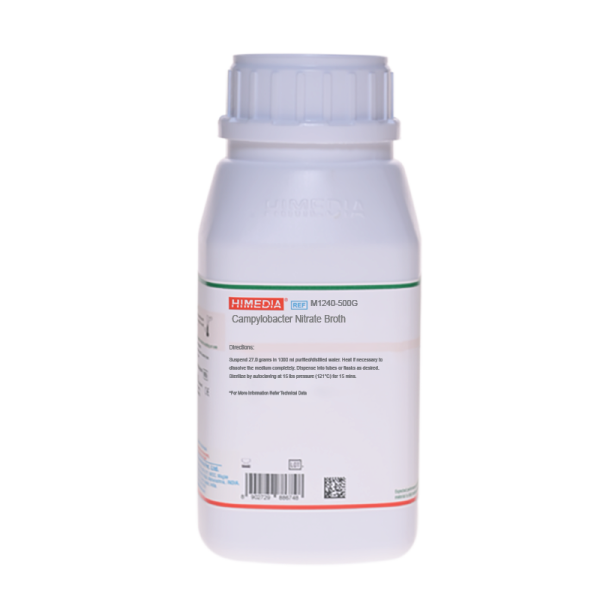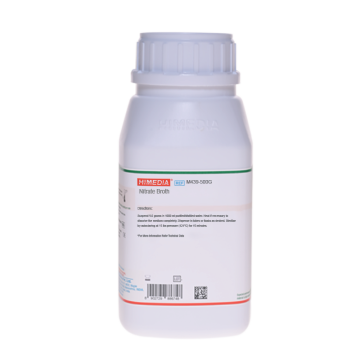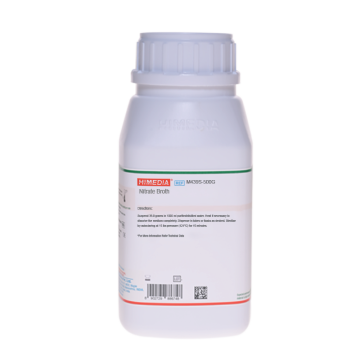 Your enquiry has been submitted
Your enquiry has been submitted
Campylobacter Nitrate Broth
Campylobacter species#CC293D
Intended Use:
Recommended for identification of Campylobacter species on the basis of nitrate reduction obtained from clinical and non- clinical samples.
Composition**
| Ingredients | g/L |
|---|---|
| HM infusion B from 500 g # | 10.000 |
| Tryptose | 10.000 |
| Sodium chloride | 5.000 |
| Potassium nitrate | 2.000 |
| Final pH (at 25°C) | 7.0±0.2 |
**Formula adjusted, standardized to suit performance parameters
# - Equivalent to Beef heart infusion from
Directions
Suspend 27.0 grams in 1000 ml purified/distilled water. Heat if necessary to dissolve the medium completely. Dispense into tubes or flasks as desired. Sterilize by autoclaving at 15 lbs pressure (121°C) for 15 mins.
Principle And Interpretation
Campylobacter species are ubiquitous in the environment inhabiting a wide variety of ecological niches (1). Infection with Campylobacter species is one of the most common causes of human bacterial gastroenteritis (1). Most species are found in animals (cattle, swine) and cause infertility and abortion. Campylobacter species are non-fermentative and non-oxidative in their metabolism, deceiving energy from the use of amino acids (2). Also, they do not ferment or oxidize the usual carbohydrate substrates. Campylobacter Nitrate Broth is formulated as per APHA(3) and is used for identification of Campylobacter species on the basis of nitrate reduction (4). Campylobacter jejuni is oxidase positive and reduces nitrates. HM infusion B from and tryptose in the medium provide the essential nutrients including mainly the nitrogenous and a few carbon compounds to Campylobacter species. Sodium chloride maintains the osmotic balance of the medium. Potassium nitrate serves as the nitrate source. Biochemical reactions by which species may be differentiated are relatively few because of their inability to ferment or oxidize the usual carbohydrate substrates.
Preparation of Nitrate Test Reagents and Technique:
- Sulphanilic acid: Dissolve 8 grams of sulphanilic acid in 1 litre 5 N acetic acid.
- Alpha-naphthylamine reagent: Dissolve 5 grams of alpha-naphthylamine in 1 litre 5 N acetic acid.
For the test:
Put 2-3 drops of each reagent into the tube containing culture to be tested. A distinct red or pink colour indicates nitrate reduction. A control (uninoculated) tube should also be tested.
Type of specimen
Clinical samples - Faeces; Food and dairy samples; Environmental samples.
Specimen Collection and Handling:
For clinical samples follow appropriate techniques for handling specimens as per established guidelines (5,6).
For food and dairy samples, follow appropriate techniques for sample collection and processing as per guidelines (3,4). After use, contaminated materials must be sterilized by autoclaving before discarding.
Warning and Precautions :
In Vitro diagnostic use. For professional use only. Read the label before opening the container. Wear protective gloves/ protective clothing/eye protection/ face protection. Follow good microbiological lab practices while handling specimens and culture. Standard precautions as per established guidelines should be followed while handling clinical specimens. Safety guidelines may be referred in individual safety data sheets.
Limitations :
- Individual organisms differ in their growth requirement and may show variable growth patterns on the medium
- Further isolation and biochemical tests must be carried out for confirmation
Performance and Evaluation
Performance of the medium is expected when used as per the direction on the label within the expiry period recommended temperature.
Quality Control
Appearance
Cream to yellow homogeneous free flowing powder
Colour and Clarity of prepared medium
Amber coloured, clear solution without any precipitate
Reaction
Reaction of 2.7% w/v aqueous solution at 25°C. pH : 7.0±0.2
pH
6.80-7.20
Cultural Response
Cultural characteristics observed after an incubation at 35-37°C for 18-24 hours.
| Organism | Growth | Nitrate reduction |
|---|---|---|
| Acinetobacter calcoaceticus ATCC 23055 | good-luxuriant | negative, no colour development |
| Campylobacter jejuni ATCC 29428 (00156*) | good-luxuriant | positive, red colour developed within 1-2 minutes |
| Escherichia coli ATCC 25922(00013*) | good-luxuriant | positive, red colour developed within 1-2 minutes |
| #Klebsiella aerogenes ATCC 13048 (00175*) | good-luxuriant | positive, red colour developed within 1-2 minutes |
| Salmonella Typhimurium ATCC 14028 (00031*) | good-luxuriant | positive, red colour developed within 1-2 minutes |
Key: *Corresponding WDCM numbers. # Formerly known as Enterobacter aerogenes
Storage and Shelf Life
Store between 10-30°C in a tightly closed container and the prepared medium at 2-8°C. Use before expiry date on the label. On opening, product should be properly stored dry, after tightly capping the bottle in order to prevent lump formation due to the hygroscopic nature of the product. Improper storage of the product may lead to lump formation. Store in dry ventilated area protected from extremes of temperature and sources of ignition Seal the container tightly after use. Product performance is best if used within stated expiry period.
Disposal
User must ensure safe disposal by autoclaving and/or incineration of used or unusable preparations of this product. Follow established laboratory procedures in disposing of infectious materials and material that comes into contact with clinical sample must be decontaminated and disposed of in accordance with current laboratory techniques (5,6).
Reference
- Manning H., Duim B., Wassenaar T., Wagenaar A., Ridley A., Newell D. G., 2001, Appl. Environ. Microbiol., 67:1185
- Koneman E. W., Allen S. D., Janda W. M, Schrenckenberger P. C., Winn W. C. Jr., 1992, Colour Atlas and Textbook of Diagnostic Microbiology, 4th Ed, J. B. Lippincott Company.
- Salfinger Y., and Tortorello M.L., 2015, Compendium of Methods for the Microbiological Examination of Foods, 5th Ed., American Public Health Association, Washington, D.C.
- Wehr H. M. and Frank J. H., 2004, Standard Methods for the Microbiological Examination of Dairy Products, 17th Ed., APHA Inc., Washington, D.C.
- Isenberg, H.D. Clinical Microbiology Procedures Handbook. 2nd Edition
- Jorgensen, J.H., Pfaller, M.A., Carroll, K.C., Funke, G., Landry, M.L., Richter, S.S and Warnock., D.W. (2015) Manual of Clinical Microbiology, 11th Edition. Vol. 1.
| Product Name | Campylobacter Nitrate Broth |
|---|---|
| SKU | M1240 |
| Product Type | Regular |
| Physical Form | Powder |
| Origin | Animal |
| Packaging type | HDPE |
| References | 1.Isenberg, H.D. Clinical Microbiology Procedures Handbook. 2nd Edition |
| Customized Product Available | No |








